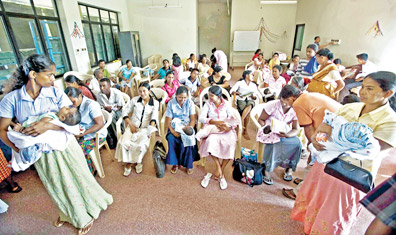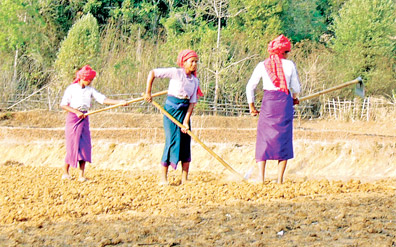|
Lanka's Human Development Index ranking:
Boost for govt's development drive
By Dhameshi Yatawara
Sri Lanka holds the 91st place in the global Human Development Index
(HDI) was a major news item during the past week. A great achievement
for Sri Lanka following a focused national development drive launched by
the Government.
|

Mothers at a post - natal clinic |
HDI, a composite measure of human development covering health and
education and income, was devised by the late Pakistani economist Mahbub
ul Haq for the first Human Development Report in 1990.
The fact that Sri Lanka is being able to maintain a relatively good
position in the HDI its overall value has grown consistently over the
past 20 years. In fact many other countries have gone way down," said
UNDP country Manager Douglas Kay talking to the 'Sunday Observer'.
South East Asia is the third fastest growing area in non income HDI.
As he explained HIV/AIDS and war are recognised as issues bringing
the most negative impact on human development. The South East Asia it
has grown as the second fastest, according to the HDI report. Sri Lanka
holds the 91 position.
In this year Sri Lanka is ranked 91 and that is above nearly 169
countries. That is right at the higher level of the medium human
development category. It is two below China, above Thailand, India,
Philippines. Despite the conflict Sri Lanka has made a difference by
investing in human development.
Among the three fastest HDI growing countries include Oman, Nepal and
Tunisia.
Data
"Data comes from many different sources. Primarily these are
Government data. Human Development Index does not develop data on its
own. It is based on existing data," said UNDP Country Director Douglas
Kay speaking to the 'Sunday Observer'. The report actually has almost 25
indices with human development. The main one is called the Human
Development Index report and this is the report what countries around
the world carefully look in to see where they are in the world.
"Analysing the past reports we see that Sri Lanka has been making a
steady progress over the past years," Kay said.
According to Kay the criteria is very broad; But mainly considers
income, education and health. Yet of course within those categories
there are many categories of information. And over the years those sub
categories have gone through some sophistication also.
The Human Development Index 2010 fortunately coincides with its 20th
anniversary. The first Human Development index was published in 1990 and
the significance was that until then major measurement of development of
a country was income or the Gross National Product (GNP).
"But we all know that does not capture the full sense of human
development. Human development is all about choices people have and not
just income, he added.
With the HDI report in 1990 the whole dialogue shifted to people and
it focused more on putting people first - the true wealth of a nation.
After all these years giving as much as investments in health,
education and all the basic necessities of the people the world has
found there are different models, different paths to gain human
development.
|

Women farmers |
But there are few factors this year's report reaffirms three factors,
i.e. equity, sustainability and empowerment.
Sustainability is enabling people to meet their needs today without
taking away from the future generation's ability to meet their needs.
What is so new about the Human Development index?
"The 2010 report introduces three new measures to the family of
indices-the Inequality adjusted Human Development Index, the Gender
Inequality Index and the Multidimensional Poverty Index," Kay added.
Poverty
These state-of-the art measures incorporate recent advances in theory
and measurement and support the centrality of inequality and poverty in
the human development framework. These experimental series are
introduced with the intention of stimulating reasoned public debate
beyond the traditional focus on aggregates. Multi Dimensional Poverty
Index looks in to health, education and living standards but not income.
"Income is not part of this index. This is to see what the people have
to develop, where is the deprivation? The three new indices will look in
to multidimensional factors in to people's measurement of development,"
he said.
Human development focuses on individual and group empowerment; human
rights, on structural safeguards. Over time national and global citizen
action has broadened the parameters of human rights, as with the global
movements that led to the UN Declaration for the Elimination of Violence
against Women and the campaigns for conventions to regulate landmines.
What would be specific of Sri Lanka?
"Considering the new three measures Sri Lankan situation is very
interesting and unique. In the Multidimensional Poverty Index Sri Lanka
stands in a unique position," Kay explained. In general it has three
dimensions mirroring the HDI-health, education and living
standards-which are reflected in 10 indicators, each with equal weight
within its dimension. Sri Lanka is outstanding in many different ways.
Human development
Within the Medium Human Development range Sri Lanka's literacy rate
is actually over 95%. While collecting data for the index, polls were
conducted in communities to get the view of the citizens of each
country. Sri Lanka has high level of positive response. People were
happy about the quality of health care that was 75% of the population.
Then 83% said good education system. 89% said air quality here is
excellent. And 86% said water quality system is excellent.
"....in some countries the resources measured by the MPI are provided
free or at low cost; in others, they are out of reach even for working
people-hence we see that countries with relatively good access to
services have an MPI that is significantly lower than monetary- based
estimates -for example, Sri Lanka, Tanzania and Uzbekistan" - HDI report
2010
Though Sri Lanka shows 14% of its population living under the poverty
line (on Financial lines) but only 5% live under the Multidimensional
Poverty line.
"This means people may not have much money but they are provided with
facilities like health, clean drinking water, hygienic facilities,
electricity etc, which contributes to better living standards of a
person," Kay said.
"The Government can be proud of their investments in free health care
and universal education has made a big impact supporting the poor. In
many other countries it is just the opposite," he said.
Accordingly Sri Lankan data shows high number of hospital beds
available. That is 31 per 10,000 people and it really stood among the
highest in the developing world. Low infant mortality is a huge success.
There is a very rapid growth in mobile and land phone connections in Sri
Lanka. Between 2000 - 2008 it has grown over 1000%.
In the medium human development range Sri Lanka is highest nation
going on mobile. This is an indication of high communication network in
the country.
The Human Development report shows that the world is becoming a very
unequal place - that is among countries and within countries. And
therefore what is happening in Sri Lanka is arguably consistent to other
parts of the world. The overall poverty in the country has generally
gone down thus it is a big success story for the Government.
At this rate Sri Lanka will achieve its Millennium Development Goals
in Poverty reduction, no doubt about it.
Looking forward
What should Sri Lanka need to look at is in terms of inequality, Kay
added. The Government of Sri Lanka is in the process of developing a
National Human Development Index supported by the UNDP in next year.
"One of the subjects in discussion is regional disparity," he said.
They highlight Gender Inequality.
In some cases Sri Lanka, according to the data that was available for
the report suggested that there need to some more attention on gender
equality. In terms of participation in the labour force Sri Lankan women
came low in the non-agricultural labour force which was 38.5%.
And so for countries in the Medium Development category it is still
low. South Asia as a region where there are having issues in not giving
women equal opportunity. "The women representing Parliament is very low
even compared to other countries in the Medium Human Development
category," he said quoting the report. The women need to be involved in
politics, development and dialogue in political representation.
"Experiences has shown in the past 40 - 50 years experience of the
world in development more involvement of women in development in family
level, in the community and ideally at the national level there are more
positive changes which are more deeper and quick," he said. Globally
this is one of the golden rules in achieving the global Millennium
Development Goals.
"There was a dearth of socio-economic information in the immediate
past from the North and the East and we hope as local administration is
getting re-established next year will be much better.
Because in order to get a better sense of Human Development of a
country, we need more data," Kay said. |

